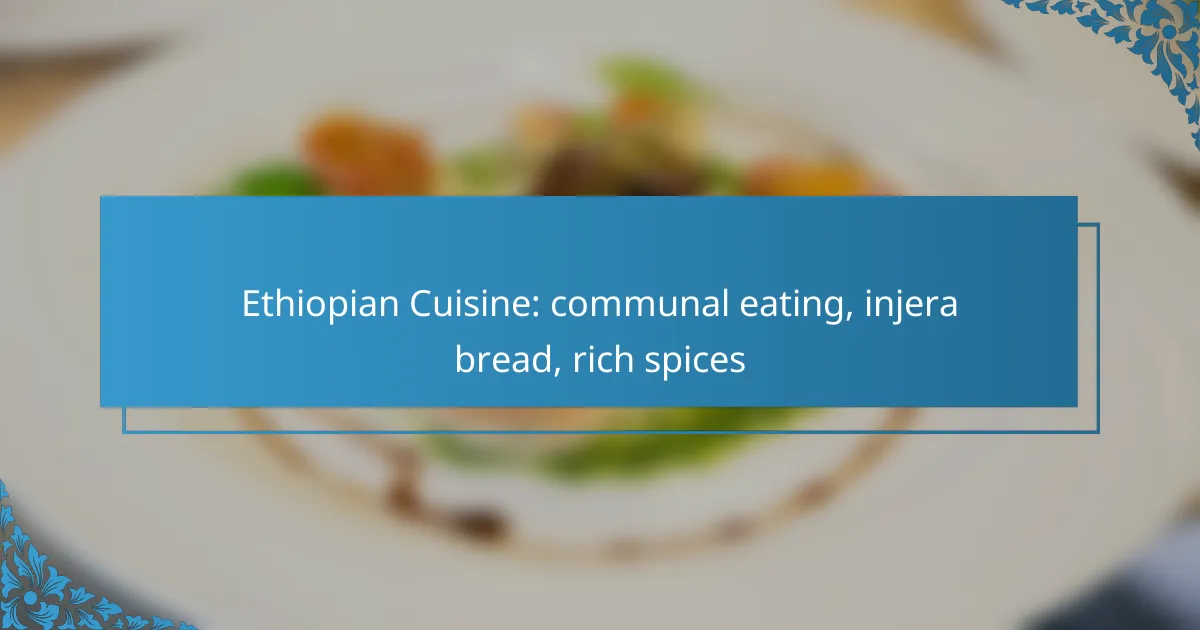Ethiopian cuisine is a vibrant tapestry of flavors, characterized by communal eating and the iconic injera bread. This spongy flatbread, made from teff flour, not only serves as a staple but also acts as a shared plate for a variety of richly spiced dishes. The tradition of gathering around a large platter fosters connection and enhances the dining experience, making each meal a celebration of community and togetherness.

What are the best Ethiopian restaurants in Los Angeles?
Los Angeles boasts a vibrant Ethiopian dining scene, with several restaurants offering authentic cuisine and communal dining experiences. The best spots feature traditional dishes like injera and rich spices, creating a unique culinary adventure.
Meskel Restaurant
Meskel Restaurant is known for its warm ambiance and extensive menu that highlights traditional Ethiopian dishes. Guests can enjoy a variety of vegetarian and meat options served on injera, a sourdough flatbread that acts as both a plate and utensil.
Popular dishes include doro wat, a spicy chicken stew, and kitfo, finely minced raw beef seasoned with spices. The restaurant also offers a selection of Ethiopian wines and coffee ceremonies, enhancing the communal dining experience.
Awash Ethiopian Restaurant
Awash Ethiopian Restaurant offers a cozy atmosphere and a diverse menu that caters to both meat lovers and vegetarians. The restaurant is particularly praised for its flavorful stews and the freshness of its injera, which is made daily.
Signature dishes include tibs, sautéed meat with vegetables, and shiro, a chickpea stew. Diners often appreciate the option to order a combination platter, allowing them to sample multiple dishes in one meal.
Little Ethiopia Restaurant
Little Ethiopia Restaurant is a staple in the Los Angeles Ethiopian community, celebrated for its authentic flavors and generous portions. The restaurant’s decor reflects Ethiopian culture, creating an inviting space for communal dining.
Menu highlights include gomen, collard greens, and various lentil dishes, all served on injera. Little Ethiopia also features a selection of traditional beverages, including tej, a honey wine, making it a great spot for a complete Ethiopian dining experience.

How to enjoy communal eating in Ethiopian culture?
Communal eating in Ethiopian culture is centered around sharing meals, fostering connection, and enjoying a variety of flavors together. This practice often involves gathering around a large platter, where everyone participates in the meal, emphasizing community and togetherness.
Sharing injera with friends
Injera, a sourdough flatbread made from teff flour, is the staple of Ethiopian cuisine and serves as both a plate and a utensil. When sharing injera with friends, diners tear off pieces to scoop up stews and salads, creating a hands-on dining experience. This method not only enhances the flavors but also encourages interaction among diners.
It’s common to have a variety of dishes served on the injera, including spicy lentils, vegetables, and meats, allowing everyone to sample different tastes. When dining, it’s polite to use your right hand, as the left hand is considered unclean in Ethiopian culture.
Understanding the role of the mesob
The mesob is a traditional Ethiopian woven basket that serves as the centerpiece for communal meals. It is typically round and elevated, making it easy for everyone to reach the food. The mesob symbolizes hospitality and is often used during special occasions and gatherings.
When using a mesob, the injera is laid out at the bottom, topped with various dishes. This arrangement not only keeps the food organized but also allows for easy sharing. After the meal, the mesob can be covered with a cloth, preserving the warmth of the food and creating a welcoming atmosphere for guests.

What is injera bread and how is it made?
Injera bread is a traditional Ethiopian flatbread made primarily from teff flour, characterized by its spongy texture and slightly sour taste. It serves as both a staple food and a communal plate for various dishes in Ethiopian cuisine.
Teff flour as the main ingredient
Teff flour is the primary ingredient in injera, derived from the tiny seeds of the teff plant, which is native to Ethiopia. This gluten-free grain is rich in protein, fiber, and essential nutrients, making it a healthy choice for many diets.
When selecting teff flour, consider its color; brown teff has a nuttier flavor, while white teff is milder. Both varieties can be used interchangeably in injera recipes, but the choice may affect the final taste and appearance.
Fermentation process for flavor
The fermentation process is crucial for developing the unique flavor of injera. Typically, the teff flour is mixed with water and left to ferment for about one to three days, depending on the ambient temperature. This fermentation creates lactic acid, which gives injera its characteristic sourness.
To ensure proper fermentation, keep the mixture in a warm place and cover it to prevent contamination. A well-fermented batter will bubble and rise, indicating it’s ready for cooking. Avoid using overly sour batter, as it can overpower the flavor of accompanying dishes.

What spices are commonly used in Ethiopian cuisine?
Ethiopian cuisine is renowned for its rich and diverse use of spices, which create bold flavors and aromas. Common spices include berbere, mitmita, and various herbs that contribute to the unique taste of traditional dishes.
Berkum spice blend
Berkum is a staple spice blend in Ethiopian cooking, known for its complex flavor profile. Typically, it includes ingredients like chili peppers, garlic, ginger, and various spices such as cumin and coriander. This blend is often used to season meats and stews, providing a warm, spicy kick.
When using berkum, consider the heat level, as it can vary significantly. Start with a small amount and adjust according to your taste preferences. It’s commonly used in dishes like doro wat, a spicy chicken stew, enhancing the overall flavor experience.
Mitmita spice mix
Mitmita is another essential Ethiopian spice mix, characterized by its fiery heat and aromatic qualities. It typically contains ground chili peppers, cardamom, and salt, making it a popular choice for seasoning raw or cooked meats. Mitmita is often served alongside dishes like kitfo, a raw minced meat dish, to elevate its flavor.
Due to its intense spiciness, use mitmita sparingly, especially if you’re not accustomed to high heat levels. It can also be sprinkled on vegetables or used as a marinade to add depth to various dishes.

How to pair Ethiopian dishes with injera?
Pairing Ethiopian dishes with injera is essential for an authentic dining experience. Injera, a sourdough flatbread, serves as both a plate and a utensil, making it perfect for scooping up various stews and salads.
Traditional dishes served with injera
Common traditional dishes that complement injera include doro wat, a spicy chicken stew, and misir wat, a lentil stew seasoned with berbere spice. Other favorites are gomen, a sautéed collard green dish, and tibs, which consists of sautéed meat with vegetables.
These dishes are typically served in a communal style, where diners share a large platter of injera topped with various stews and sides. This encourages a social atmosphere and enhances the overall dining experience.
Flavor combinations to enhance the meal
When pairing flavors with injera, consider the balance of spices and textures. The tanginess of injera complements the rich, spicy flavors of dishes like doro wat, while milder options like gomen provide a refreshing contrast.
To enhance your meal, try adding a sprinkle of mitmita, a spicy chili powder, or a drizzle of olive oil to your dishes. This can elevate the flavors and add an extra layer of depth to the meal.

What are the health benefits of Ethiopian cuisine?
Ethiopian cuisine offers numerous health benefits, primarily due to its use of whole grains, legumes, and a variety of spices. The communal eating style encourages sharing, which can promote healthier portion control and social interaction.
High fiber content from injera
Injera, a staple in Ethiopian meals, is made from teff flour, which is naturally high in fiber. This high fiber content aids digestion and can help maintain a healthy weight by promoting a feeling of fullness.
Incorporating injera into meals can support heart health by lowering cholesterol levels and regulating blood sugar. A typical serving of injera can provide a significant portion of the daily fiber recommendation, making it a nutritious choice.
Rich in antioxidants from spices
Ethiopian cuisine is renowned for its use of spices like berbere and mitmita, which are rich in antioxidants. These spices can help combat oxidative stress in the body, potentially reducing the risk of chronic diseases.
Common spices used in Ethiopian dishes, such as garlic, ginger, and turmeric, have been linked to anti-inflammatory properties. Including these spices in your diet can enhance overall health and may contribute to improved immune function.

What are the cultural significance and traditions of Ethiopian meals?
Ethiopian meals hold deep cultural significance, emphasizing communal eating and rich flavors. The tradition of sharing food fosters connection and community, making meals a central aspect of social life.
Celebrations and communal gatherings
In Ethiopia, meals are often the centerpiece of celebrations and communal gatherings, such as weddings, holidays, and religious events. These occasions typically feature an array of dishes served on a large platter, allowing everyone to share and partake in the feast together.
During such gatherings, injera, a sourdough flatbread, serves as both a plate and a utensil, with various stews and salads placed on top. This communal style of dining reinforces bonds among family and friends, creating a sense of unity and togetherness.
Etiquette during meals
Etiquette during Ethiopian meals is rooted in respect and tradition. It is customary to wash hands before eating, as food is often consumed without utensils. Guests are typically encouraged to eat with their right hand, as the left is considered unclean.
When sharing food, it is polite to serve others before serving oneself, reflecting the importance of generosity. Additionally, it is common to express appreciation for the meal and the host, reinforcing social bonds and gratitude within the community.
